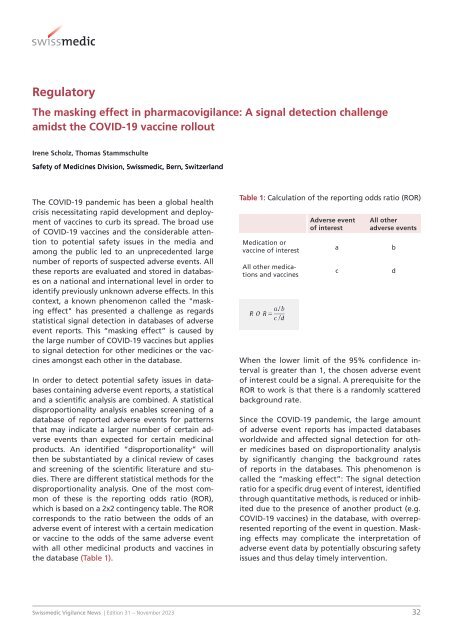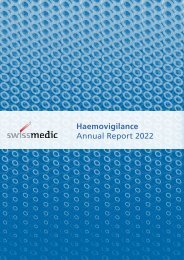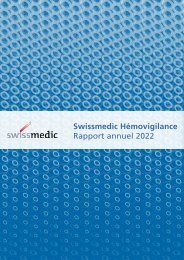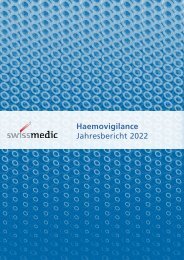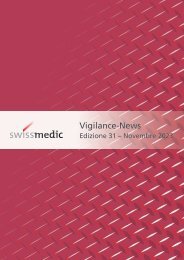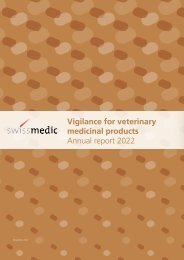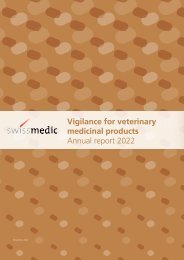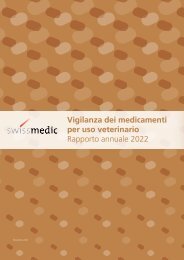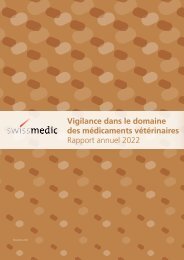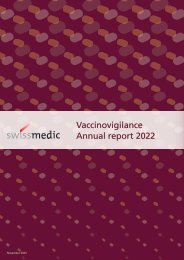Swissmedic Vigilance News
Edition 31 – November 2023
Edition 31 – November 2023
You also want an ePaper? Increase the reach of your titles
YUMPU automatically turns print PDFs into web optimized ePapers that Google loves.
Regulatory<br />
The masking effect in pharmacovigilance: A signal detection challenge<br />
amidst the COVID-19 vaccine rollout<br />
Irene Scholz, Thomas Stammschulte<br />
Safety of Medicines Division, <strong>Swissmedic</strong>, Bern, Switzerland<br />
The COVID-19 pandemic has been a global health<br />
crisis necessitating rapid development and deployment<br />
of vaccines to curb its spread. The broad use<br />
of COVID-19 vaccines and the considerable attention<br />
to potential safety issues in the media and<br />
among the public led to an unprecedented large<br />
number of reports of suspected adverse events. All<br />
these reports are evaluated and stored in databases<br />
on a national and international level in order to<br />
identify previously unknown adverse effects. In this<br />
context, a known phenomenon called the "masking<br />
effect" has presented a challenge as regards<br />
statistical signal detection in databases of adverse<br />
event reports. This “masking effect” is caused by<br />
the large number of COVID-19 vaccines but applies<br />
to signal detection for other medicines or the vaccines<br />
amongst each other in the database.<br />
In order to detect potential safety issues in databases<br />
containing adverse event reports, a statistical<br />
and a scientific analysis are combined. A statistical<br />
disproportionality analysis enables screening of a<br />
database of reported adverse events for patterns<br />
that may indicate a larger number of certain adverse<br />
events than expected for certain medicinal<br />
products. An identified “disproportionality” will<br />
then be substantiated by a clinical review of cases<br />
and screening of the scientific literature and studies.<br />
There are different statistical methods for the<br />
disproportionality analysis. One of the most common<br />
of these is the reporting odds ratio (ROR),<br />
which is based on a 2x2 contingency table. The ROR<br />
corresponds to the ratio between the odds of an<br />
adverse event of interest with a certain medication<br />
or vaccine to the odds of the same adverse event<br />
with all other medicinal products and vaccines in<br />
the database (Table 1).<br />
Table 1: Calculation of the reporting odds ratio (ROR)<br />
Medication or<br />
vaccine of interest<br />
All other medications<br />
and vaccines<br />
Adverse event<br />
of interest<br />
a<br />
All other<br />
adverse events<br />
When the lower limit of the 95% confidence interval<br />
is greater than 1, the chosen adverse event<br />
of interest could be a signal. A prerequisite for the<br />
ROR to work is that there is a randomly scattered<br />
background rate.<br />
Since the COVID-19 pandemic, the large amount<br />
of adverse event reports has impacted databases<br />
worldwide and affected signal detection for other<br />
medicines based on disproportionality analysis<br />
by significantly changing the background rates<br />
of reports in the databases. This phenomenon is<br />
called the “masking effect”: The signal detection<br />
ratio for a specific drug event of interest, identified<br />
through quantitative methods, is reduced or inhibited<br />
due to the presence of another product (e.g.<br />
COVID-19 vaccines) in the database, with overrepresented<br />
reporting of the event in question. Masking<br />
effects may complicate the interpretation of<br />
adverse event data by potentially obscuring safety<br />
issues and thus delay timely intervention.<br />
c<br />
b<br />
d<br />
<strong>Swissmedic</strong> <strong>Vigilance</strong> <strong>News</strong> | Edition 31 – November 2023<br />
32


